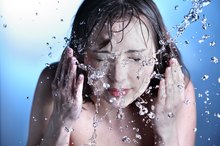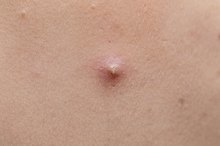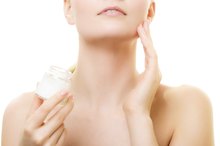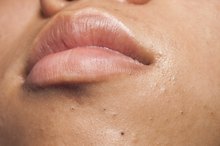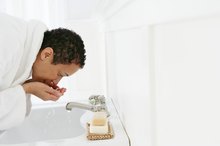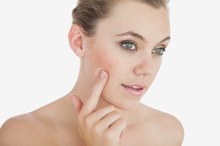Facial Scars From Blackhead Extraction
Facial scars from blackhead extraction are the result of damage to the deeper layers of your skin. It can be difficult to eradicate blackheads, which may make it tempting to extract them. However, you should refrain from doing so yourself. Seek a professional's help to avoid long-lasting damage to your skin that can be difficult, if not impossible, to reverse.
Significance
A blackhead is a pin-sized dot that appears when your pores become partly blocked with sebum, dead skin cells and bacteria, according to AcneTalks.com. In the dermatological world, blackheads are called open comedones. The combination actually does not turn black until it is exposed to air--the chemical reaction causes the contents to appear black. Blackheads are caused by dehydration, excess facial oil, overexfoliation, excess dead cells or insufficient cleansing.
- A blackhead is a pin-sized dot that appears when your pores become partly blocked with sebum, dead skin cells and bacteria, according to AcneTalks.com.
Effects
How to Soften a Hard Blackhead
Learn More
An estimated 95 percent of acne patients experience some form of scarring, according to DERMAdoctor.com. When a blackhead is extracted, the pore can rupture. This releases the sebum, dead skin cells and bacteria deep within the dermis, which is the layer of skin beneath the epidermis. The eruption causes an inflammatory response that can reduce collagen in your skin. The result is an acne scar that can be difficult to treat and reverse.
- An estimated 95 percent of acne patients experience some form of scarring, according to DERMAdoctor.com.
- The result is an acne scar that can be difficult to treat and reverse.
Warning
When you extract a blackhead, the pressure placed on the pore causes extra, immediate damage to your skin. Extraction also leaves the pore more vulnerable and open to bacteria, which can cause infection or another blackhead to accumulate, according to AcneTalks.com. The severity of an acne scar can differ, depending on heredity. Therefore, it's important to leave blackhead extraction to a professional, who can perform the process in a way that minimizes scarring.
- When you extract a blackhead, the pressure placed on the pore causes extra, immediate damage to your skin.
- Extraction also leaves the pore more vulnerable and open to bacteria, which can cause infection or another blackhead to accumulate, according to AcneTalks.com.
Prevention
Embedded Blackheads & Pits
Learn More
Blackhead prevention begins with a proper skin treatment routine that involves twice-daily cleansing and weekly exfoliation of your skin. If you are prone to blackheads, a topical treatment--such as benzoyl peroxide or salicylic acid--can help slough away the matter that fills the pores, according to AcneTalks.com.
If you have blackheads that do not subside with treatment, seek help from a professional aesthetician or dermatologist. These professionals will remove blackheads in a manner that keeps the pores open to minimize damage.
- Blackhead prevention begins with a proper skin treatment routine that involves twice-daily cleansing and weekly exfoliation of your skin.
- If you have blackheads that do not subside with treatment, seek help from a professional aesthetician or dermatologist.
Solution
If you do experience scarring because of blackhead extraction, there are treatments available, according to Acne.org 2. Laser resurfacing reaches into the skin's dermal layers to encourage collagen production. Chemical peels involve applying an acid to the skin. The acid burns off the outer layer of skin cells to remove scar tissue, revealing healthy skin underneath. Another technique, known as dermabrasion, helps remove the skin's top layers using a specialized instrument. While these treatments may prove effective in reducing the appearance of acne scars, they may not completely eradicate them 24.
Related Articles
References
- Acne Talks: What Is Blackhead? A Nine Point Answer To Your Most Basic Query! Part I
- Acne.org: Acne Scar Treatments
- TeensHealth: Can Acne Scars Be Removed?
- AcneNet: Acne Scars
- Cunliffe, WJ. Acne. Abingdon, UK: Taylor & Francis; 1999.
- American Academy of Dermatology Association. Acne: overview. Updated 2019.
- Freshwater, D, Masiln-Prothero, S. Blackwell's Nursing Dictionary. Hoboken, NJ: Wiley; 2013.
- InformedHealth.org [Internet]. Cologne, Germany: Institute for Quality and Efficiency in Health Care (IQWiG); 2006-. Acne: Do lotions, tablets or light-based treatment help? 2013 Jan 13.
- Stearn, M. The Must-Have Health Guide. Basel, Switzerland; Karger Medical and Scientific Publishers; 2005.
- Plewig, G, Melnik, B, Chen, W. Plewig and Kligman's Acne and Rosacea. New York, NY: Springer International Publishing; 2019.
- Kosmadaki M, Katsambas A. Topical Treatments for Acne. Clinics in Dermatology. 2017 Mar - Apr;35(2):173-178.
- Saurat JH. Strategic Targets in Acne: The Comedone Switch in Question. Dermatology. 2015;231(2):105-11.
- Zaenglein AL, Pathy AL, Schlosser BJ, et al. Guidelines of Care for the Management of Acne Vulgaris. Journal of the American Academy of Dermatology. 2016 May;74(5):945-73.
Writer Bio
Rachel Nall began writing in 2003. She is a former managing editor for custom health publications, including physician journals. She has written for The Associated Press and "Jezebel," "Charleston," "Chatter" and "Reach" magazines. Nall is currently pursuing her Bachelor of Science in Nursing at the University of Tennessee.
